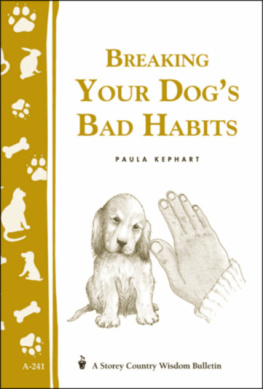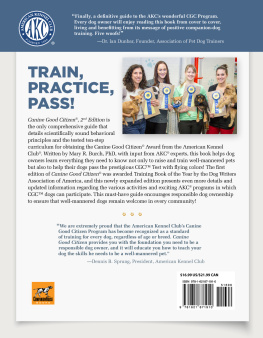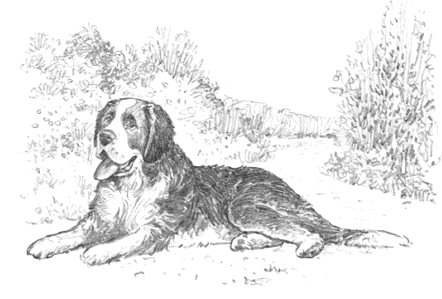Breaking Your Dogs Bad Habits
Paula Kephart
CONTENTS
Introduction
Some of the bad habits that dogs develop are only mildly annoying, but others can lead to serious consequences. Whatever the habit or your level of concern, there comes a time when you realize that the habit must go. With your help, your dog can replace his bad habit with acceptable behavior in just a few weeks.
Retraining your dog does not necessarily call for a lot of extra time and effort on your part. Most retraining requires one or two 10-minute sessions a day. Once your dog has begun to figure out what you want from him, you can integrate continued retraining into the ordinary routines of your day.
Whats Causing the Misbehavior?
There are a number of factors that can contribute to the development of behavioral problems. Poor health, old age, or the quirks of a particular breed may be to blame. Before you start retraining your dog, take some time to assess the factors that are contributing to your dogs bad habit. If you understand the problem, youll find it easier to bring about a successful solution.
Is Your Dog Healthy?
Before you assume that your dogs misbehavior is willful, make sure that there is not an underlying health problem. Its not hard to imagine how a urinary tract infection, poor vision, diminished hearing, or other health problems could affect your dogs behavior. Before tackling the bad habit, its a good idea to discuss the problem with your dogs veterinarian to rule out any health factors.
Is the Habit Connected to Age?
Some bad habits are more common at certain ages. Just think of the bad habits a puppy can get into because of his need to chew. And an unresponsive dog may simply be old and losing her hearing!
Puppies. Bad habits can develop if a puppy is weaned and removed from the litter too early. Watch a litter of puppies with their mother. What looks like play to us is really the process of doggie socialization. As they tumble about together, the littermates learn the limits of acceptable behavior and the importance of rank. If a puppy is removed from the litter too early, he may not have the opportunity to learn the pack rules. Eight weeks is the youngest age at which a puppy should be taken from his mother and siblings; 10 to 12 weeks is better.
Adolescents. Dogs, like humans, go through a physical maturation process that includes adolescence. The physical and hormonal changes of adolescence, which occur between 3 and 6 years (human) of the dogs life, can sometimes undermine her ability to focus and behave appropriately. The keys to getting through this stage are patience and consistency.
Older dogs. Changes at the other end of the age continuum can affect a dogs behavior, too. Around your dogs eighth year, you may begin to notice physical evidence of the aging process. The dog moves more slowly as joints become less flexible. An older dog whose sight or hearing has diminished may be startled enough to snap at a hand reaching out to pat her. Changes in blood flow and blood-oxygen levels can impair a dogs cognitive processes, slowing her reactions.
The onset of aging is influenced by many variables, including breed, size (small dogs tend to have a longer life span than large dogs), health history, and the quality of care the dog has received. A dog that has been healthy, active, and well taken care of throughout her life may not show any evidence of age-related changes for several years after her eighth birthday.
Is Your Dog Confused about Whos in Charge?
Dogs, like people, exhibit a wide range of personalities and traits. This is what makes a dog so appealing and, at times, exasperating. A dog with an eager-to-please personality is much less likely to develop bad habits such as ignoring you or challenging your authority. On the other hand, this personality type may foster bad habits such as whining, begging for food or attention, and separation anxiety.
A dog with a confident personality doesnt demand a lot of your attention or affection. She seems to relish new experiences and adapts well to changes. Generally she is not afraid to make new friends among dogs or people. However, you may sometimes find yourself in a whos the boss struggle with a confident dog.
Canine Jekyll and Hyde
Some dogs have distinctive character traits that can, when activated, override their usual demeanor. Sam, my 90-pound black Lab/German shepherd mix, is a good example. Generally loving and playful by nature with both dogs and people, he loses all control when another dog trespasses by walking along the street in front of his home. Although 7 years old, Sam can clear the 4-foot fence around the yard with ease to challenge the trespasser. His behavior is motivated not by viciousness but by anxiety about the safety of his family. While it may be endearing that hes willing to face his anxiety head on, the resulting behavior causes a fair amount of chaos.
Dominance factor refers to how submissive or dominant a dog tends to be with people and other dogs. His tendency toward dominance or submissiveness is not set in stone and can vary depending on the situation. For example, Gracie, my black Lab/beagle mix, is an outgoing 2-year-old. She loves people and generally runs up toor afteranyone she sees to say hello. Yet she is very timid with other dogs and cowers when one comes along.
If your dog has a strong dominance trait, you need to be clear and consistent about your behavioral expectations and limits for him. Otherwise, your dog may get into the bad habit of taking charge, which can lead to an array of other habits, including overprotective and threatening behaviors.
Is Your Dog Outsmarting You?
If your dog is alert and quick to learn, you may find his repeated bad habit perplexing and aggravatingif hes so smart, why is he acting so badly? Although you might expect a dim-witted dog to develop bad habits, in truth its often the opposite. A highly intelligent dog is a pleasure to train and have as a companion, but he is more likely to look forand findsolutions to what he considers problems. For example, if he is shut in a fenced-in yard, he may figure out how to unlatch the gate to escape. Proud as the owner may be of her dogs resourcefulness, leaving the yard without permission is definitely a bad habit.
Was Your Dog Bred for Trouble?
Personality, intelligence, the dominance factor, and health are all influenced to some degree by the dogs breed. In addition, breed dogs may develop certain bad habits simply because they were bred for for certain characteristics. Beagles, for example, like to dig and whine. Labrador retrievers have a propensity for jumping or even climbing fences. Dogs bred to herd animals may exercise that tendency with the neighborhood children.
Saint Bernards make great family dogs because they were bred to be large, strong, loyal, and friendly. Without proper training, however, they can become overprotective of their owners.
Are You Giving Your Dog Mixed Messages?
One final factor that cannot be overlooked when investigating your dogs bad habit is you, the owner. Your attitude, expectations, self-confidence, and understanding of your dog have a definite influence on him. For example, if you dont give commands in a serious manner, and if you dont take the time at the onset of training to ensure and insist that your dog obey your commands, your dog may learn that he doesnt have to obey.
To be successful in retraining, it is important to clarify for yourself exactly which behaviors are acceptable and which are unacceptable. For example, do you want your dog not to jump on anyone? Or is jumping an acceptable way to greet family members, but not visitors? Do you want your dog to stay off all the furniture? Or is it okay for her to sleep on your bed? Once youve identified which behaviors you want and those you dont, it will be much easier to give a clear message to your dog.






